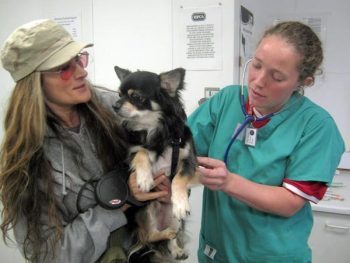30 Nov 2017
Zoe Belshaw takes an evidence-based look at these consults, unwrapping their complex and multi-layered nature...

IMAGE: Maria Sbytova/Fotolia.
Dog and cat vaccination consultations may be considered by some practice staff as routine, simple, time-saving appointments that are relatively stress-free for both vet and client. But research has suggested these are myths that need busting.
Despite comprising up to one-third of all consultations in some practices, little research has been conducted on what happens during dog and cat vaccination consultations in the UK.
Originally, these consultations were focused on the delivery of vaccines, and flea and worm treatment, with the clinical examination used to ensure the animal was well enough for products to be administered.
Major changes have occurred to the way we deliver preventive health care in the UK.
The vaccine consult has widely been rebranded as an annual health check; its remit expanded into discussing past and present health conditions, and preventive health care. Pet health care plans, meanwhile, are exponentially increasing in number, changing how preventive medicines are discussed inside and outside the consulting room (Ravetz, 2017).
In addition, a huge surge has occurred in the number of corporate practices, which could lead to changes in preventive medicine brands, protocols and targets for preventive health care.
The impact of these changes on what happens, and how owners and general practitioners view vaccination consultations, is the subject of research at The University of Nottingham Centre for Evidence-Based Veterinary Medicine (CEVM). This article covers what we have learned to date – which suggests these consultations can be particularly difficult – and points towards some research questions that need addressing.

Interest is growing in general practice consultations and data is being gathered using several different, complementary methods.
Groups such as VetCompass and the University of Liverpool Small Animal Veterinary Surveillance Network are collecting “big data” recorded by vets via the computers in consulting rooms.
This provides access to millions of case records and permits population conclusions to be drawn, such as which disorders are most commonly recorded in different species and at what age (O’Neill et al, 2014a; 2014b), and the demographics of our pet population (Sánchez-Vizcaíno et al, 2017).
However, these data do not give us the complete picture. For one, we know vets do not record everything they do or discuss in the consult on the computer.
In fact, a study compared what was written on the computer at the end of the consultation with observed data in the consulting room about what was said, and found fewer than 65% of observed problems were recorded and fewer than 60% of actions were written down (Jones-Diette et al, 2016). Standing in the consulting room, while laborious, means we can be confident we know what has happened.
This approach was taken by Natalie Robinson at the CEVM and has informed much of our knowledge about the content of individual consultations, including preventive health care consults (Robinson et al 2015a; 2015b).
While both approaches tell us what happens, they do not tell us why they happen, or what vets and owners think about participating in these consultations. To answer these questions, we need to use techniques, such as surveys and interviews, that ask broad questions to understand what else is going on – both inside and outside the consulting room – which may influence what happens.
These qualitative research methods can provide some of the most interesting data – and we are using these methods to further our understanding of vaccination consultations and health checks.

Thanks to data gathered using these research methods, we have discovered much of what we thought we knew about dog and cat vaccine consultations was wrong.
Rather than being quick and easy, dog and cat vaccine – or preventive health care – consults can be the most challenging consultations.
Compared to consultations for new health problems, or recheck examinations, vaccination and health check consults are more complex in numerous ways.
Firstly, they are more likely to include both a weight check and full clinical examination, increasing the probability new health problems will be identified.
For example, in some observed consultations, up to eight problems were discussed (Robinson et al, 2015a).
Secondly, problems are more likely to be raised by the vet than the owner, which may lead to more difficult conversations. Thirdly, owners are more likely to present multiple animals in a single consultation when they come for a health check than any other time (Robinson et al, 2016).
The problems discussed are also different. For example, dental disease and behaviour are more likely to be discussed during preventive health care consultations than any other time (Robinson et al, 2016).
Plus, as demonstrated by the ongoing debate about brachycephalic dog health and welfare (Packer et al, 2017), owners may be uncertain what is driving changes in their pets’ behaviour, or even what is normal, so may be reluctant to talk about behavioural issues with a vet until they are causing big problems (Roshier and McBride, 2013).
Because of this, and with behaviour problems a leading cause of euthanasia in young dogs (O’Neill et al, 2016), a health check may quickly become a more difficult consultation.
Preventive health care consultations involve discussion about preventing, rather than treating, disease. This can lead to conversations about risks and benefits that are harder than, for example, when the owner’s animal has already suffered an injury or contracted an infection.
Owners and vets conceptualise risk differently (Belshaw et al, 2016), so negotiations may be involved. In addition, a huge amount of information and opinion is available about the risks and benefits of preventive health care, which owners may access at any time – some of which can be very persuasive to an owner already tending towards risk aversion.

Therefore, discussion about the pros and cons of using preventive medicines may be more frequent and harder than a decade ago.
Guidelines about when and how to vaccinate dogs and cats have been produced (Day, 2017), but it is not known how widely these have been adopted.
Most practices will have a policy on what to prescribe and when to vaccinate, what with, how often and in what site. However, this may need adapting from pet to pet, with influencing factors including the animal’s history, health status, temperament and owner wishes. This can present some challenges.
Questions with no robust evidence to guide decision-making, meanwhile, include how best to deal with animals with immune-mediated disease, deliver a kennel cough vaccine and manage an animal previously vaccinated with vaccines of a different brand, and the role of titre testing.
Despite their complexity, most adult pet vaccination consultations in the UK are the same length as those booked for a single problem (Robinson et al, 2014). At 10 to 15 minutes typically, it is likely some of these consults will be conducted under significant time pressure.
Preventive health care consultations are complex from the point of view of the vet, but may also be difficult for clients.
Vets may conduct their consults differently, and changes to the vaccine brand, adoption of a practice pet health care plan or changes in targets may mean the annual booster consultation undergoes big changes in a year.
If these changes have not been well communicated to owners, particularly if they only visit the practice once a year with a healthy pet, they may find themselves confused about what to expect.
It is likely no perfect way exists to perform a vaccination or health check to suit every vet, pet and owner, and recognising that diversity is incredibly important. However, some broad suggestions may help.
We’re working on this at the CEVM and hope to have news soon.